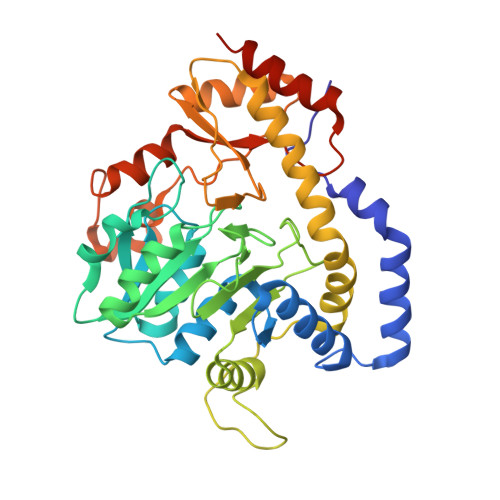Structural analysis of QdtB, an aminotransferase required for the biosynthesis of dTDP-3-acetamido-3,6-dideoxy-alpha-D-glucose.
Thoden, J.B., Schaffer, C., Messner, P., Holden, H.M.(2009) Biochemistry 48: 1553-1561
- PubMed: 19178182
- DOI: https://doi.org/10.1021/bi8022015
- Primary Citation of Related Structures:
3FRK - PubMed Abstract:
3-Acetamido-3,6-dideoxy-alpha-d-glucose or Quip3NAc is an unusual deoxyamino sugar found in the O-antigens of some Gram-negative bacteria and in the S-layers of Gram-positive bacteria. It is synthesized in these organisms as a dTDP-linked sugar via the action of five enzymes. The focus of this investigation is on QdtB from Thermoanaerobacterium thermosaccharolyticum E207-71, a PLP-dependent aminotransferase that catalyzes the penultimate step in the production of dTDP-Quip3NAc. For this analysis, the enzyme was crystallized in the presence of its product, dTDP-Quip3N, and the structure was solved and refined to 2.15 A resolution. QdtB is a dimer, and its overall fold places it into the well-characterized aspartate aminotransferase superfamily. Electron density corresponding to the bound product reveals the presence of a Schiff base between C-4' of the PLP cofactor and the amino nitrogen of the sugar. Those amino acid side chains involved in binding the dTDP-sugar into the active site include Tyr 183, His 309, and Tyr 310 from subunit 1 and Lys 219 from subunit 2. Notably there is a decided lack of interactions between the pyranosyl C-4' hydroxyl of the dTDP-sugar and the protein. In keeping with this observation, we show that QdtB can also turn over dTDP-3-acetamido-3,6-dideoxy-alpha-d-galactose. This investigation represents the first structural analysis of a sugar-modifying aminotransferase with a bound product in its active site that functions at the C-3' rather than the C-4' position of the hexose.
Organizational Affiliation:
Department of Biochemistry, University of Wisconsin, Madison, Wisconsin 53706, USA.















